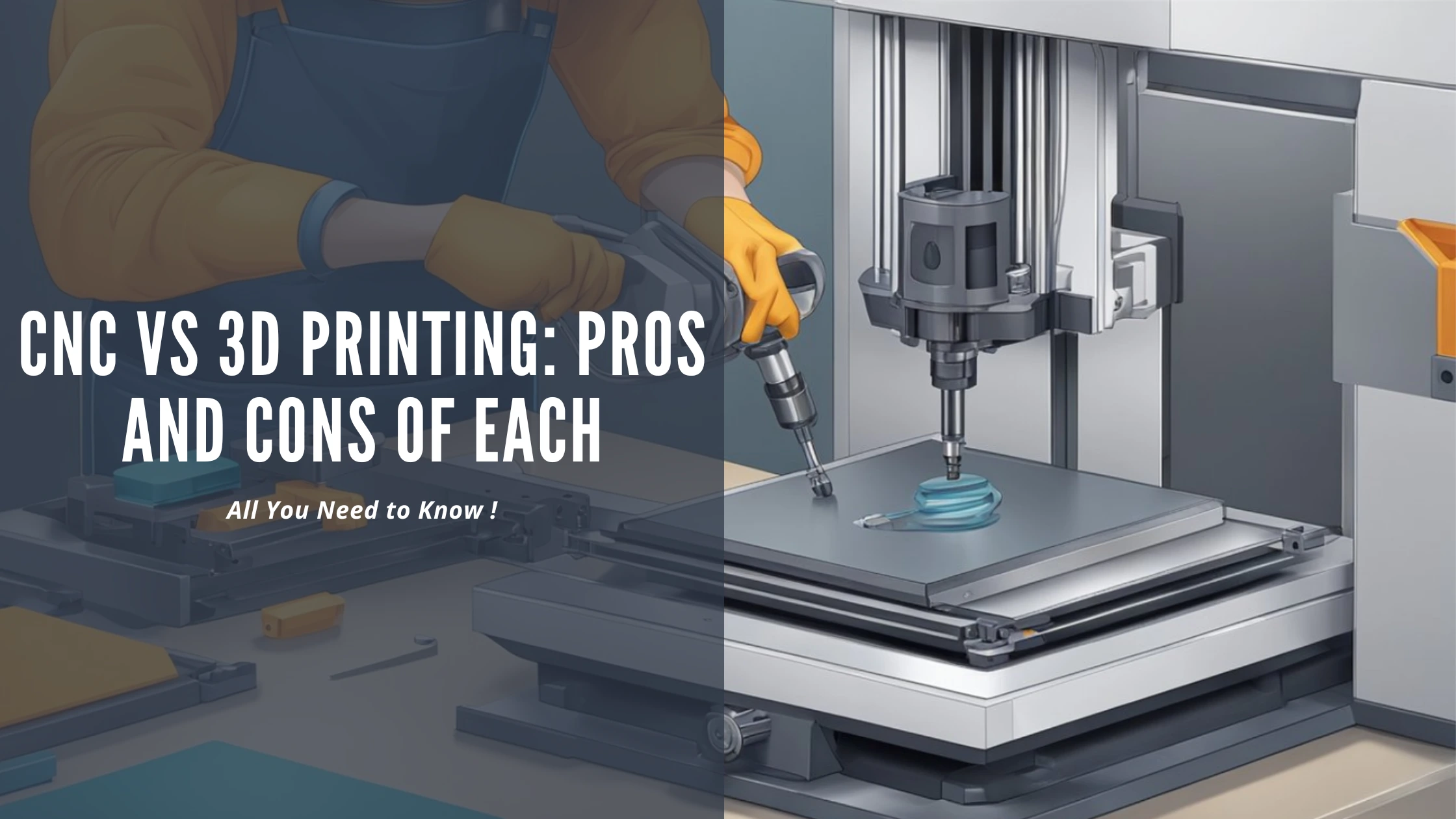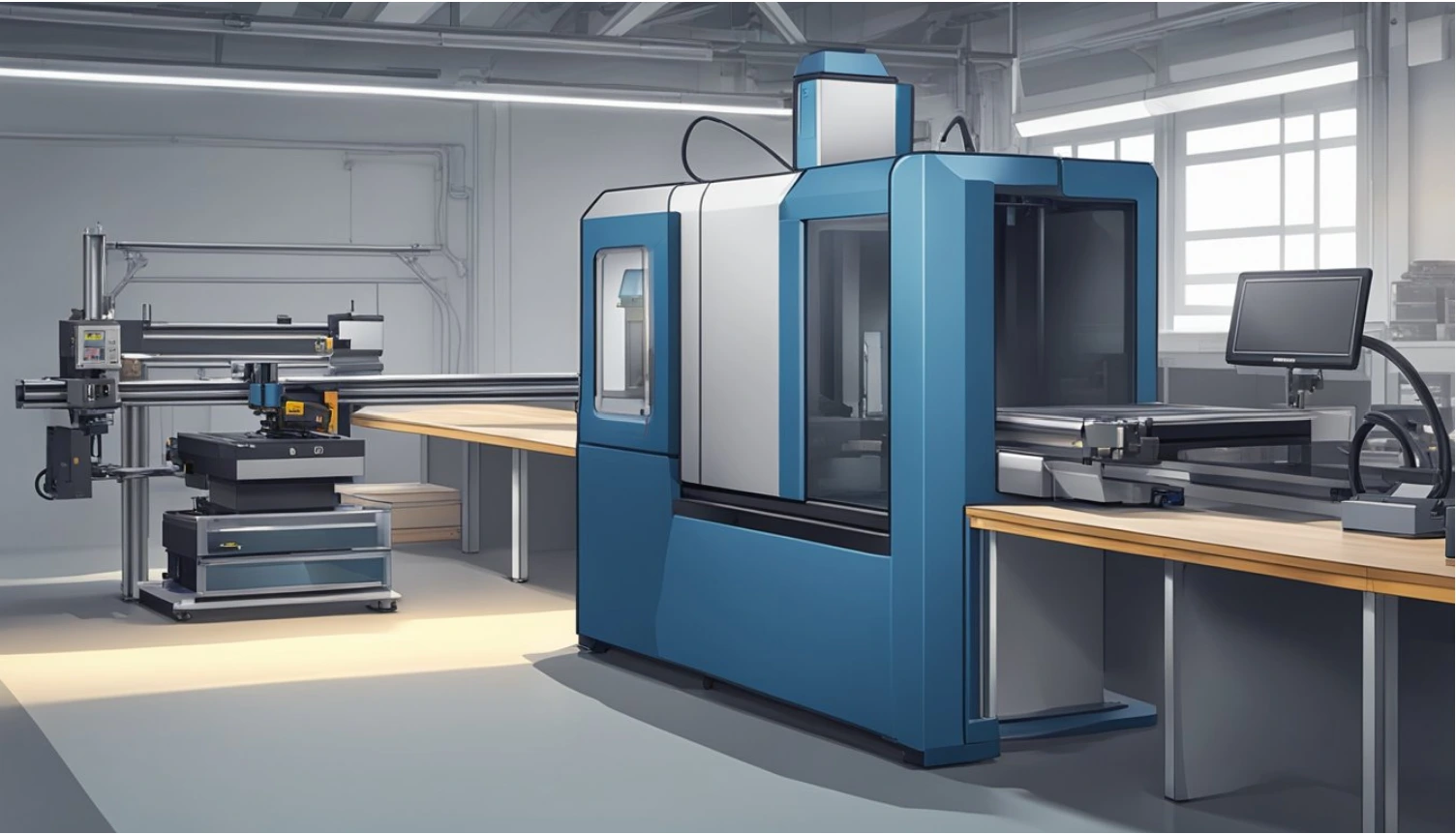CNC vs 3D Printing: Pros and Cons Of Each

Between CNC machining and 3D printing, one question often arises: which method is best suited for a specific project?
This depends on the desired accuracy, material considerations, complexity of the design, and production volume – basically, it depends on the scenario.
Quick Overview
CNC machining is a subtractive method, while 3D printing is an additive process, offering different advantages for manufacturing.
Material considerations, design complexity, and production volume play a role in deciding the best method for a project.
Both CNC and 3D printing have versatile applications, spanning across industries such as aerospace and automotive.
When To Use Each
CNCs:
Cutting wood furniture parts with precise detail
Carving decorative signs and lettering out of various materials
Producing metal parts for machines/tools rapidly
Engraving stone and glass, such as for awards or sentimental gifts
Manufacturing injection molds to enable mass production
Creating custom PCB circuit boards quickly
Machining foam/composites for model planes & cars
3D Printers:
Prototyping plastic product designs before mass production
Customized medical implants
Producing specialized lab equipment on demand
Printing specialized drone & robot components
Architectural and construction models
Rapid jewelry wax model-making
Dental crowns & aligners
Overview of CNC and 3D Printing
CNC Machining
CNC (Computer Numerical Control) machining is a subtractive manufacturing process where the material is removed from a workpiece by cutting tools controlled by a computer program. CNC machining is known for its accuracy, high speed, and ability to work with a wide range of materials, including metals, plastics, and composites.
The CNC industry is predicted to reach $115 billion by 2026, with growth expected to come with increasing use of automation and AI technologies.
The CNC machine uses various cutting tools for different operations, such as milling, turning, drilling, and grinding, allowing for high-precision and complex parts to be produced.
Some key features of CNC machining include:
High precision
Wide range of compatible materials
Capable of producing complex geometries
Fast production time
3D Printing
3D printing, also known as additive manufacturing, is a process that creates physical objects by building them up layer by layer from a digital model. Unlike CNC machining, 3D printing does not require tools, making it easy to create complex and intricate designs with minimal waste.
The 3D printing market is smaller than the CNC market, worth around $16.75bn in 2022. But, it’s growing by more than 20% per year as a part of the fourth industrial revolution.
There are several different 3D printing techniques, such as Fused Filament Fabrication (FFF), Stereolithography (SLA), and Selective Laser Sintering (SLS), each offering different benefits depending on the application and material used.
Some advantages of 3D printing include:
Ability to create complex geometries (that CNC machines just can’t make)
Minimal waste
Lower setup cost
Suitable for small batches and prototyping
3D printing and CNC both have their unique benefits and drawbacks, making them more suited for different applications. CNC machining has the upper hand when it comes to precision, speed, and material compatibility, while 3D printing offers greater design freedom and minimal waste.
Material Considerations

When comparing CNC and 3D printing technologies, it's essential to consider the materials that each process supports. Both CNC machining and 3D printing offer a wide range of materials, but the specific types and their characteristics can influence your decision.
Material Types for CNC
CNC machining is extremely versatile and supports a multitude of materials ranging from metals, plastics, and even wood. Some common materials include:
- Metals: Aluminum, stainless steel, and titanium are popular choices for CNC machining thanks to their strength and durability.
- Plastics: Materials like Nylon and PEEK are known for their light weight and wear resistance, making them suitable for CNC applications.
- Wood: CNC machining can handle various wood types, providing an organic look and feel to finished products.
Machined parts deliver native material properties, including structural strength, hardness, and electrical conductivity, contributing to their widespread use in various industries.
Material Options for 3D Printing
3D printing, also known as additive manufacturing, utilizes different materials to create parts by building them layer by layer. A few popular 3D printing material options are:
- Thermoplastics: PLA (Polylactic Acid) is a widely used material in 3D printing because it is environmentally friendly, easy to print, and cost-effective.
- Nylon: This durable and flexible material is perfect for producing strong 3D printed parts, resistant to wear and tear.
- Metals: 3D printing can also work with metals such as aluminum and titanium. However, it should be noted that 3D printing metal parts can be more expensive and time-consuming than CNC machining.
- Ceramics: While less common than other materials, 3D printing with ceramics is possible, suitable for unique applications and industries.
3D printing excels when creating complex and intricate designs, which may be difficult or impossible to produce with CNC machining. However, 3D printed parts may not offer the same strength and durability as their CNC counterparts, depending on the material selected.
In conclusion, material considerations play a crucial role in deciding whether CNC machining or 3D printing is the better choice for a specific project. Careful evaluation of material properties, product requirements, and available budget will help guide the decision-making process.
Applications and Use-cases
Prototyping with CNC and 3D Printing
Both CNC machining and 3D printing have pivotal roles in prototyping for industries like aerospace, robotics, and construction. CNC machining excels in producing highly accurate and smooth parts, making it ideal for components that require precise dimensions.
But, only 3D printing can create complex geometries with unique patterns that CNC can’t, and it also produces less waste as it is additive.
3D printing is also more affordable and simpler to use compared to CNC machining, making it especially attractive for rapid prototyping and design iterations.
Some typical applications in the aerospace industry include:
- CNC: aircraft engine components, landing gear parts, and structural components.
- 3D printing: lightweight brackets, air ducts, and cabin components.
In the robotics field, common uses are:
- CNC: custom gears, precise joints, and motor mounts.
- 3D printing: custom housings, end effectors, and flexible grippers.
Production and Manufacturing
When it comes to production and manufacturing, both CNC and 3D printing are employed for a wide variety of applications, often complementing one another. For instance, CNC machining is commonly used for high-precision tasks, while 3D printing is more suitable for complex and organic shapes. Here are some examples in specific industries:
Aerospace:
CNC | 3D Printing |
|---|---|
Engine Parts | Lightweight Structure |
Turbine Blades | Fuel Nozzles |
Wing Spars | Satellite Parts |
Robotics:
CNC | 3D Printing |
|---|---|
Metal Linkages | Complex Internal Structures |
Milled Brackets | Custom sensor housings |
Actuator components | Grippers with integrated flexibilty |
Comparing CNC and 3D Printing
1. Cost Efficiency and Volume
CNC machining tends to be more expensive for small-volume production due to the setup and labor involved. 3D printing is generally more cost-effective for smaller batches, as it requires less initial setup and material preparation.
However, CNC machining becomes more cost-efficient for larger production volumes, as the cost per unit decreases with increased volume.
Both manufacturing technologies can handle various materials, but the range of materials for 3D printing is currently more limited, primarily focusing on plastics, resins, and a few metals (but for metal 3D printing you’ll need an industrial 3D printer anyway).
2. Speed and Precision
CNC machining can be significantly faster than 3D printing, particularly for parts that require high levels of precision and tight tolerances. The speed and precision of CNC machining result from its use of a rotating cutting tool that removes material from a larger block. This process avoids the need for multiple layers (like 3D printing does), resulting in faster production times.
3D printing builds parts layer by layer, which can be slower, especially for larger and more complex parts.
Manufacturing Technology | Speed | Precision |
|---|---|---|
CNC Machining | Faster | Higher |
3D Printing | Slower | Lower |
3. Finish and Complexity
Regarding surface finish, CNC machining typically produces parts with a better finish and stronger mechanical properties in all dimensions.
Though, 3D printing excels in creating highly complex, geometrically intricate parts that might be challenging for CNC machines to produce due to tool access, path limitations, and minimum radii constraints.
Comparatively, 3D printed parts may require post-processing to achieve a smoother finish, which can increase overall production time and cost.
Pros and Cons of Each
Advantages and disadvantages of CNC Machining
Pros of CNC Machining:
High accuracy, precision, and repeatability in manufacturing.
Versatility in working with a variety of materials, including plastics and metals.
Rapid production, suitable for tight deadlines.
Excellent surface finishes, ensuring a smooth and polished final product.
Efficient in creating complex parts with minimal waste using subtractive manufacturing.
Cons of CNC Machining:
Design limitations in producing intricate geometries or internal structures.
Generates more waste (chips and cuttings) compared to 3D printing.
Benefits and drawbacks of 3D Printing
Pros of 3D Printing:
Offers great design freedom with the ability to create intricate and complex shapes.
Cost-effective for small-scale production and prototyping, requiring less machinery and material investment.
Reduced waste, as it only uses material necessary for the part, making it environmentally friendly.
Constantly advancing technology, expanding the range of usable materials.
Cons of 3D Printing:
Weaker parts compared to CNC machined parts.
Achieving smooth surface finishes can be challenging, often needing extra post-processing.
Susceptible to issues like warping and nozzle clogging in FDM machines, affecting productivity.
Limited range of materials, especially with certain metal alloys and other specific materials.
